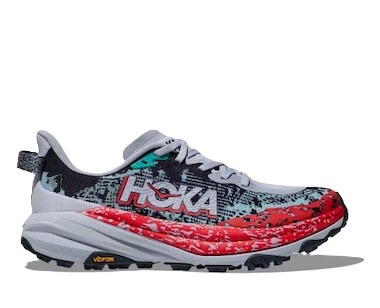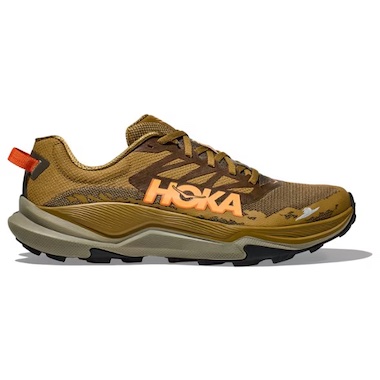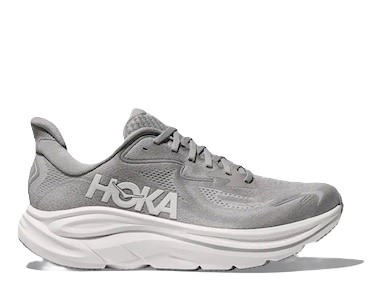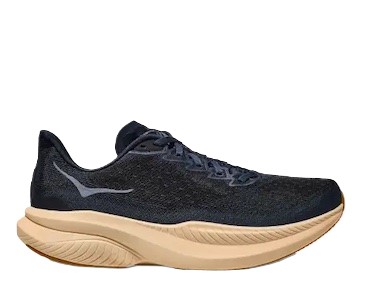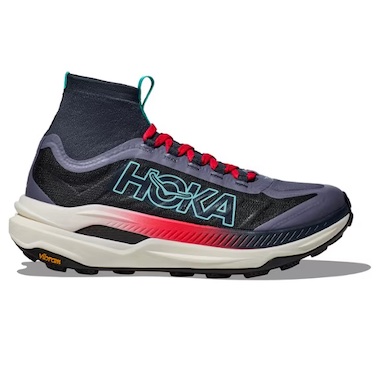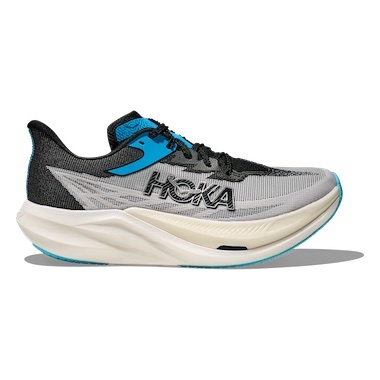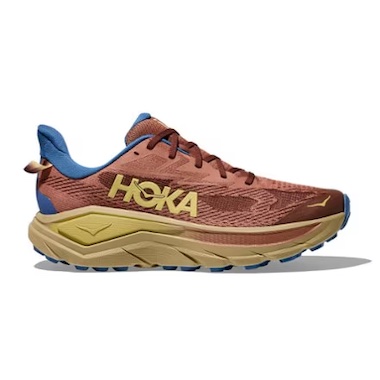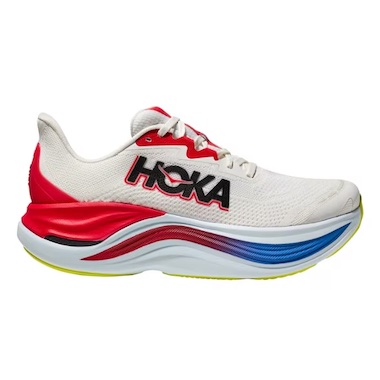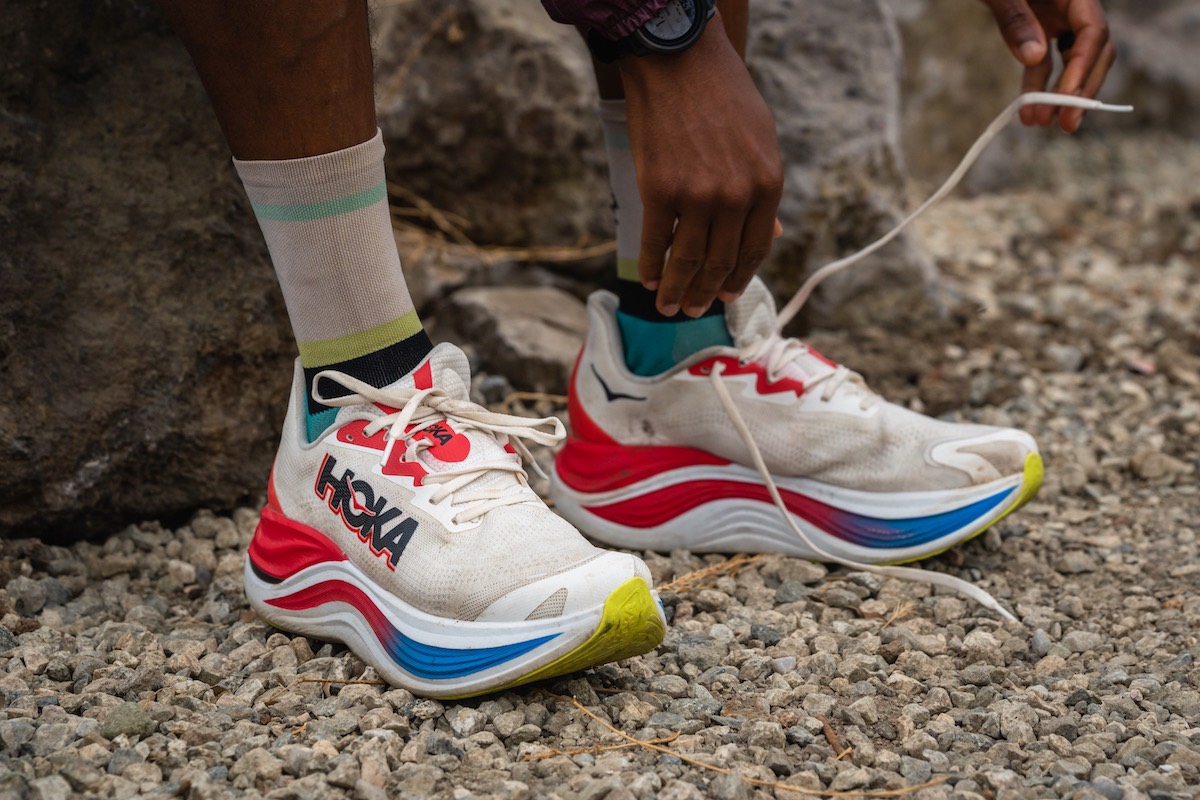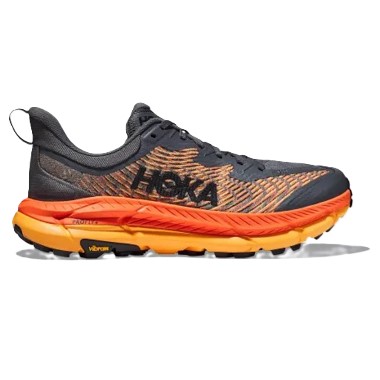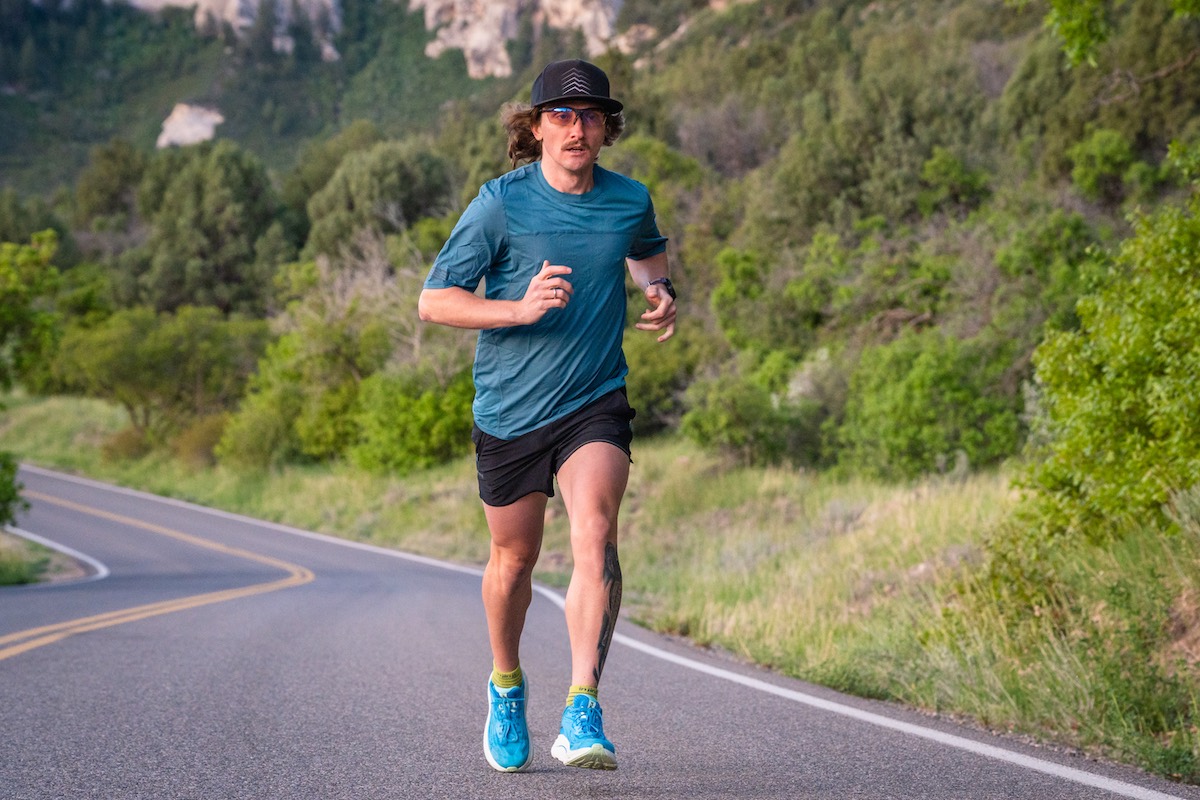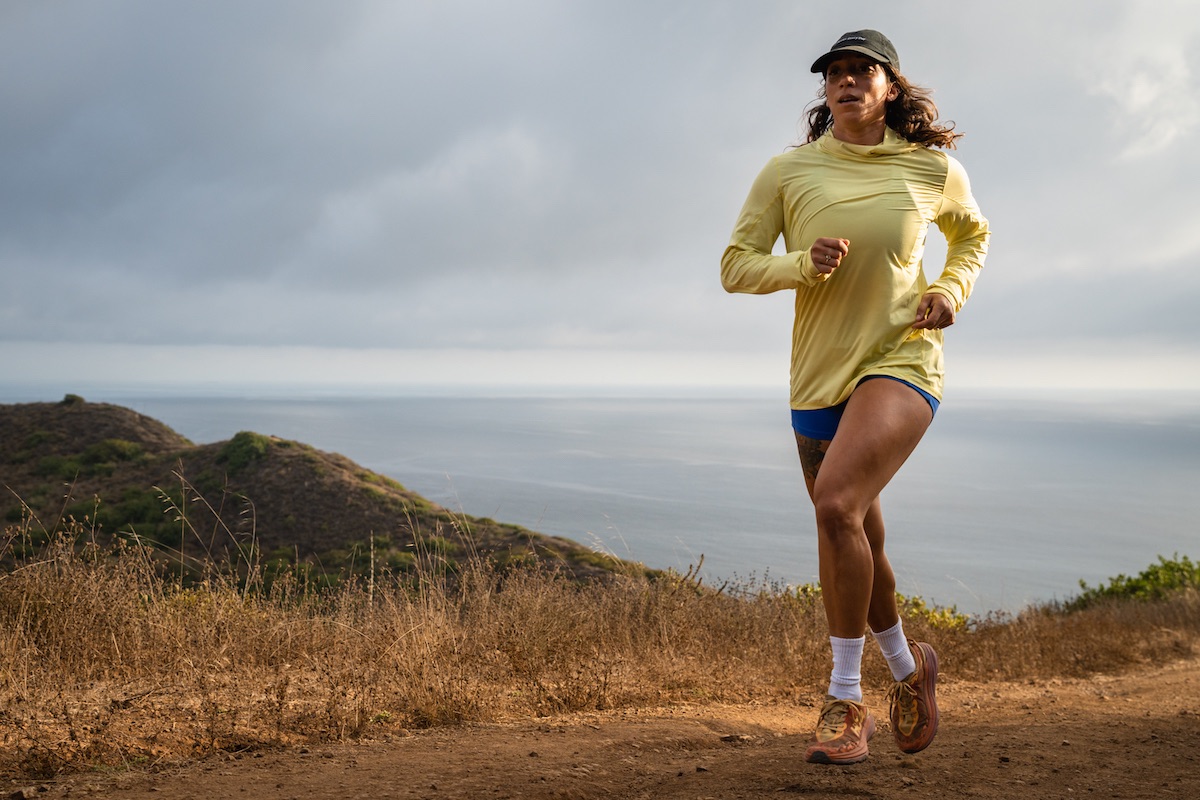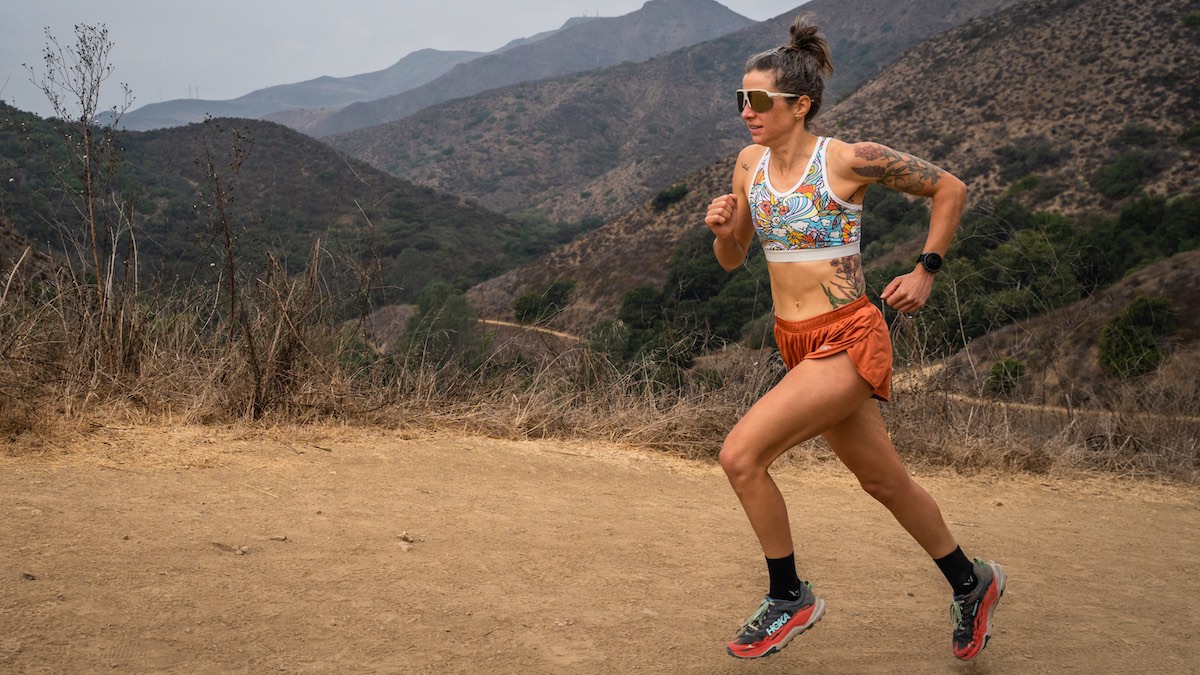
iRunFar’s Alli Miles runs in a pair of the Hoka Torrent 4 trail running shoes. Photo: iRunFar/Eszter Horanyi
Born in the 2000s, in an age of minimalist running shoes, Hoka went against the proverbial grain, creating ultra-cushioned running shoes. Nowadays, Hoka has grown into one of the most popular American running shoe brands, and it’s undoubtedly one of the most common brands we get asked about as iRunFar gear testers. So we decided to pool our collective knowledge, experience, and testing of shoes from the brand to create a buyer’s guide to the best Hoka running shoes.
Two of the brand’s most popular shoes come out on top, as we name the Hoka Speedgoat 6 the best overall trail running shoe and the Hoka Clifton 10 the best overall road running shoe. Both shoes are excellent options for newbies to elite runners. They’re durable, approachable, and reasonably affordable. But beyond the best overall shoes for trails and roads, we look at the best Hoka options for racing, cushioning, roads to trails, and more.
Read on, and be sure to look at our testing methodology, buying advice, and frequently asked questions below our top picks.
Best Hoka Running Shoes
- Best Overall Trail Running Shoe: Hoka Speedgoat 6
- Best Overall Trail Running Shoe — Runner-Up: Hoka Torrent 4
- Best Overall Road Running Shoe: Hoka Clifton 10
- Best Overall Road Running Shoe — Runner-Up: Hoka Mach 6
- Best Trail Racing Shoe: Hoka Tecton X 3
- Best Road Racing Shoe: Hoka Rocket X 3
- Best Road-to-Trail Running Shoe: Hoka Challenger 8
- Best Maximally Cushioned Road Running Shoe: Hoka Skyward X
- Best Running Shoe for Technical Terrain: Hoka Mafate Speed 4
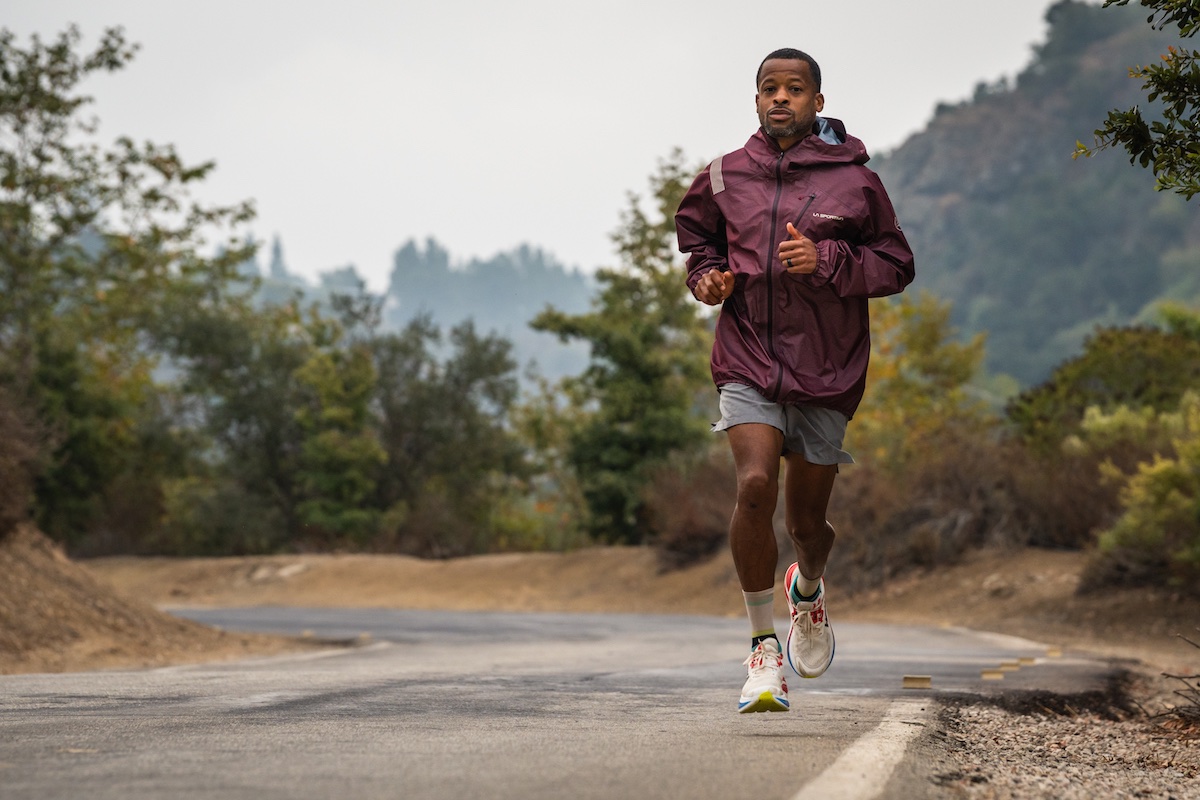
Keith Kilgore Jr. running in the Hoka Skyward X maximum cushioned shoe. Photo: iRunFar/Eszter Horanyi
Best Overall Trail Running Shoe: Hoka Speedgoat 6 ($170)
Pros:
- Excellent traction and lug pattern
- Lightest and most responsive version ever
- Better midfoot lockdown
- Improved upper
Cons:
- The lacing system is definitely not the best
- Decals might come off relatively quickly
This line of shoes is a brand classic, but the Hoka Speedgoat 6 has a slightly new design that is a bit controversial. The new tongue is oddly small, and the lacing system isn’t the best. That said, we believe the other improvements to the newest version of this classic outweigh those design flaws that we hope Hoka will address in the next update.
Our favorite update to the sixth iteration of this shoe is the midsole. It’s a new, lighter, firmer, and more responsive midsole compound. Folks who like the softness of previous versions of this shoe might not be keen on the update, but we think it’s an overall improvement for the shoe, making it better for workouts and up-tempo work. Hoka changed the lug pattern slightly on the outsole, but we didn’t notice any significant changes from previous versions in terms of performance. It still has grippy rubber and 5-millimeter lugs to give you confidence in ripping downhills and efficiency on uphills.
All this adds up to make the Speedgoat 6 our favorite all-around Hoka trail shoe, and it’s at the top of our list in our Best Trail Running Shoes guide. If you run primarily on trails, this is the pick for you.
Read our full Hoka Speedgoat 6 review to learn more.
Actual Weight (U.S. men’s 9): 9.8 ounces (280 grams) | Stack Height (heel/toe): 40/35 millimeters | Drop: 5 millimeters
Shop the Men's Hoka Speedgoat 6Shop the Women's Hoka Speedgoat 6
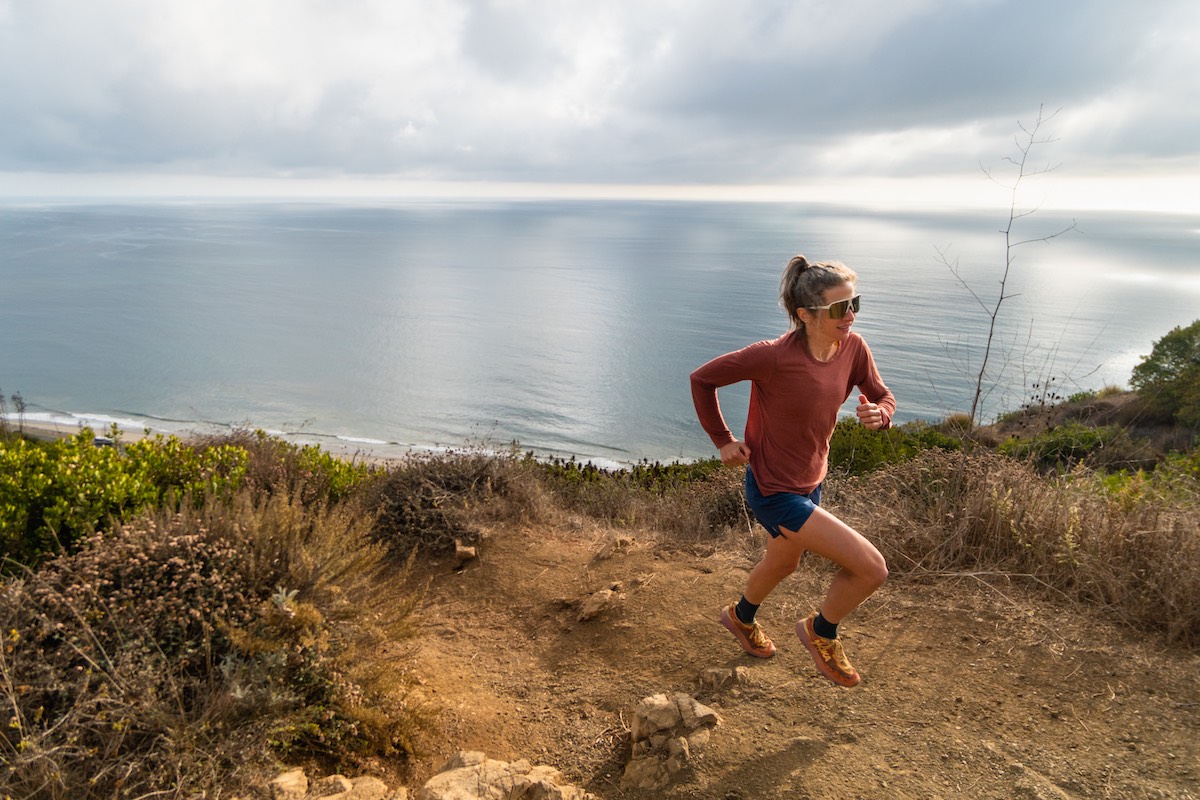
Alli Miles runs in the Hoka Speedgoat 6 trail running shoes in California’s Santa Monica Mountains. Photo: iRunFar/Eszter Horanyi
Best Overall Trail Running Shoe — Runner-Up: Hoka Torrent 4 ($130)
Pros:
- Excellent value
- Good all-around trail shoe
- Good for beginners
- Better durability than previous models
Cons:
- Not a specialty shoe
The Hoka Torrent 4 is an excellent all-around trail running shoe at a good value. We recommend it for beginner trail runners and more experienced trail runners looking for a better value shoe than the Hoka Speedgoat 6.
When a shoe gets major updates, it can go one of two ways. We’re happy to report that Hoka nailed it on this one. Starting at the bottom, Hoka rearranged its lug orientation and shape. The multi-directional lug shape resembles the bottom of the Speedgoat 6 and helps on uphills and downhills. Also similar to the Speedgoat 6, the lugs are now five millimeters deep, up from four in the previous model. We found these outsoles to have a very reliable grip on multiple surfaces and trail types.
Moving up the shoe, Hoka also employed a new midsole foam. They shifted from a dual-density EVA foam in the previous model to a single-layer EVA foam and added two extra millimeters of underfoot stack height. They also widened the base of the midsole around the heel for boosted stability. While there are certainly more cushioned shoes and more responsive shoes, we found the Torrent 4 hit an excellent balance of cushion and responsiveness.
The newest model’s upper did not change much. We found it secure and comfortable. Overall, at $130, this is an excellent value shoe, especially for those dabbling in trail running.
Read our full Hoka Torrent 4 review.
Actual Weight (U.S. men’s 9): 9 ounces (254 grams) | Stack Height (heel/toe): 33/28 millimeters | Drop: 5 millimeters
Shop the Men's Hoka Torrent 4Shop the Women's Torrent 4
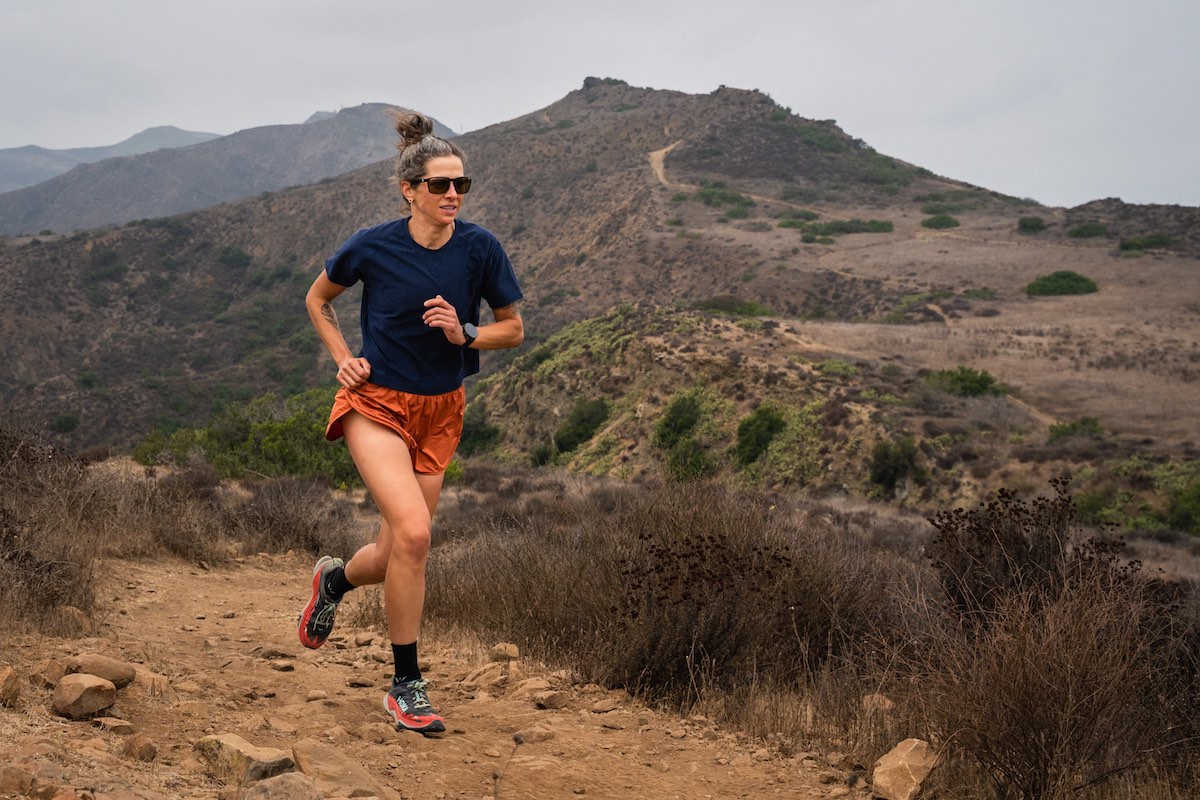
Alli Miles running in the Hoka Torrent 4 trail running shoes in Ventura County, California. Photo: iRunFar/Eszter Horanyi
Best Overall Road Running Shoe: Hoka Clifton 10 ($150)
Pros:
- Great all-around training shoes for road and gravel
- Amazing cushion
- Lightweight construction
- Truly neutral
Cons:
- It might be too wide for narrow feet
The Hoka Clifton 10 is one of the most popular and best-selling road shoes in the brand’s lineup, and that’s for good reason. It’s a very solid, comfortable, durable, and approachable training shoe. Starting at the top, Hoka uses its jacquard knit upper material for the upper. The fit at the forefoot is slightly wider, which we like. Hoka also added some padding around the heel for improved comfort. An already super comfortable shoe got even better with the upper upgrades.
Moving down, Hoka uses its lightweight and responsive compression-molded EVA foam. The big update is an additional three millimeters of drop between the heel and forefoot. Previous models had a 5-millimeter drop, and this one increases to 8 millimeters. We honestly didn’t notice much of a difference, so don’t be too concerned if you’re a shoe-drop nerd. The foam is still durable and highly comfortable. It is cushy and responsive and helps create a shoe you can take out of the box and take on a long run right away. Hoka still uses its typical rubber outsole, which we’ve also found very durable.
Is the Clifton 10 a shoe that will get you Strava course records or personal bests in races? No. But will it be a shoe that gives you hundreds of training miles to get you closer to Strava course records or personal bests? Definitely. And, for that, we love them. Also, note that the Clifton 10 is truly a neutral shoe, which some will prefer. It also happens to be one of our favorite road running shoes.
Read our full Hoka Clifton 10 review to learn more.
Actual Weight (U.S. men’s 10): 9.8 ounces (278 grams) | Stack Height (heel/toe): 35/27 millimeters | Drop: 8 millimeters
Shop the Men's Hoka Clifton 10Shop the Women's Hoka Clifton 10
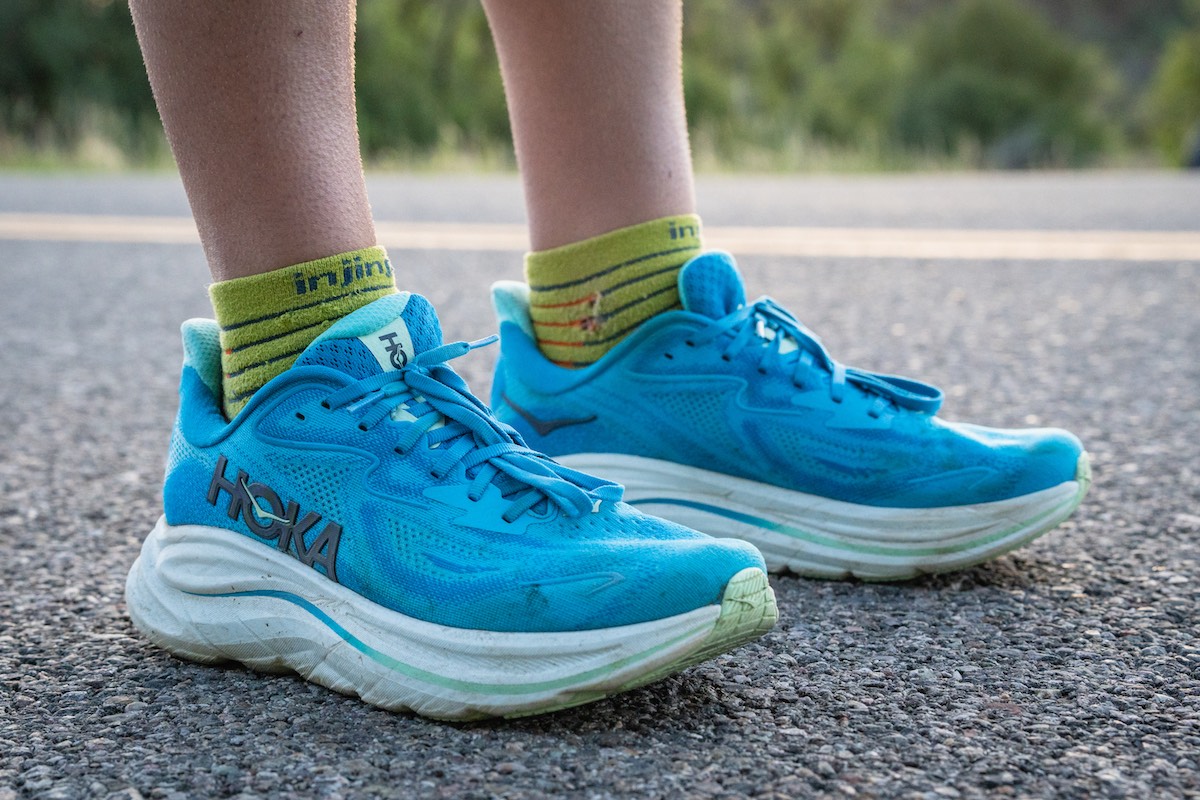
The Hoka Clifton 10 is our favorite overall Hoka running shoe for roads. Photo: iRunFar/Eszter Horanyi
Best Overall Road Running Shoe — Runner-Up: Hoka Mach 6 ($140)
Pros:
- Excellent shoe for training, tempos, and races
- Good value
- Durable
- Tons of fun
Cons:
- Some Mach disciples didn’t love the fit
The Hoka Mach 6 is one of the most fun road shoes we’ve recently tested. It’s lightweight, responsive, comfortable, plush, and fast. It can serve as your everyday trainer, a workout shoe, or even a race-day shoe. We’re fans of the Mach series, but this might be the best version of the shoe yet. The bottom has a rubber outsole designed for durability and minimal weight. So far, more than 100 miles into the shoe, we haven’t noticed any excessive wearing issues. Considering we’ve put 500-plus miles on previous versions of the Mach, we don’t anticipate these wearing out too fast.
Moving up the shoe to the midsole, things start to get more fun. Hoka uses its super-critical midsole foam, which is lightweight and responsive. The creel jacquard upper adds to the overall comfort of the shoe. At just 8.2 ounces, the shoe is incredibly light. And the 5-millimeter heel-to-toe drop is ideal for most runners.
Overall, this is an excellent shoe. If you’re looking for a pure road trainer, we recommend the Clifton 10, but if you’re looking for a more versatile shoe that works for speed workouts and road races, the Mach 6 is the better pick.
Actual Weight (U.S. men’s 9): 8.2 ounces (232 grams) | Stack Height (heel/toe): 37/32 millimeters | Drop: 5 millimeters
Shop the Men's Hoka Mach 6Shop the Women's Hoka Mach 6

Keith Kilgore Jr. testing the Hoka Mach 6 in Ventura County, California. Photo: iRunFar/Eszter Horanyi
Best Trail Racing Shoe: Hoka Tecton X 3 ($275)
- Speedy and smooth shoe for shorter to mid-distance trail races (think up to a 25k or so)
- The new Matryx upper is more flexible, durable, and comfortable than the previous version
- Good enough traction for most terrain
- Carbon plate offers incredible uphill propulsion
Cons:
- The previous pair started falling apart for those with wider feet at around 300 miles
- Running hard down steep, technical descents can feel overly wild with the aid of the carbon plate
The Hoka Tecton X 3 is Hoka’s premier trail racing shoe. We distinctly remember when we heard about the first version of this shoe on a Hoka press call. A carbon plate in a trail running shoe? What’s the world coming to, we pondered. It turns out, we loved it. The original version of this shoe was responsive, fast, and a helluva lot of fun. Two versions later, and the shoe is still (mostly) that.
We’ll address the elephant in the room right away. If you’ve run in or at least seen the two previous versions of the Tecton X, you’ll likely notice a major structural change to the X 3. Hoka added a built-in gaiter. While we definitely prefer the previous version with no built-in gaiter, it wasn’t as annoying as we expected. Still, we’d recommend Hoka removing it for the next version.
Everything else about the shoe is mostly the same as the previous version, which is definitely a good thing. Our only complaint with the original model was that after 300 miles, the upper started ripping from the midsole, creating a gap for the outside portion of our main tester’s feet. Hoka significantly upgraded the second version of this shoe, including a Matryx upper, which Hoka says is hydrophobic and will help repel water and trail debris. We’ve put in hundreds of miles on the X 2 and X 3 and they’re much more sturdy than the original version.
The Vibram Megagrip with Litebase outsole is solid for most terrain and trail surfaces, but there are better options for super loose or technical terrain. But if you’re looking to go fast, these are your ideal shoes for trail races of up to 25 kilometers, speed workouts, and speedy long runs. We’d say the other major elephant in the room for this shoe is its cost. If you’re a serious trail racer and/or have the budget to spend $275 on a pair of shoes, we think it’s worth it. But if you’re not racing trails seriously, you’re definitely good to get by in the Hoka Speedgoat 6 or Hoka Torrent 4.
Actual Weight (men’s 9): 9.3 ounces (265 grams) | Stack Height (heel/toe): 30 millimeters/25 millimeters | Drop: 5 millimeters
Shop the Men's Hoka Tecton X 3Shop the Women's Hoka Tecton X 3
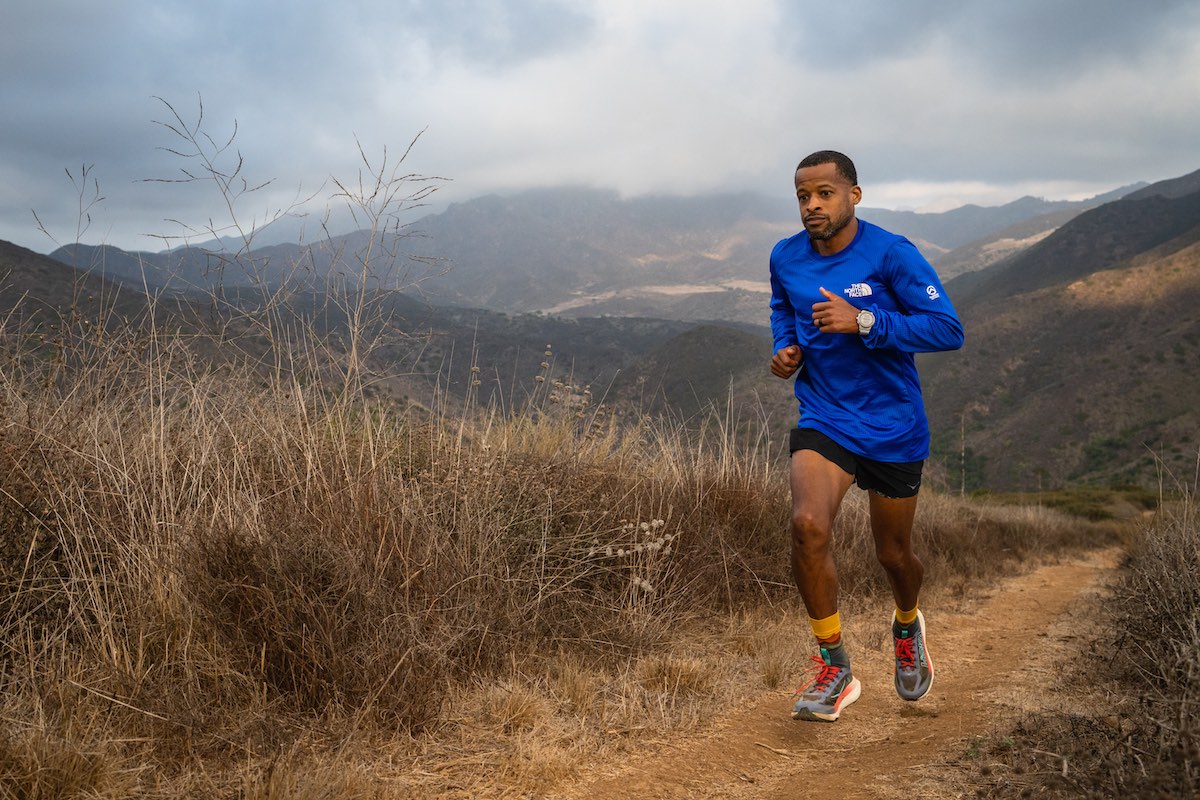
Keith Kilgore Jr. running in the Hoka Tecton X 3 trail racing shoes in California’s Santa Monica Mountain range. Photo: iRunFar/Eszter Horanyi
Best Road Racing Shoe: Hoka Rocket X 3 ($250)
- Good entry to super shoes
- The rocker and carbon plate are incredibly responsive
- Lightweight and good fit
Cons:
- Not the lightest or fastest super shoe available
The Hoka Rocket X 3 isn’t the fastest or lightest road racing super shoe on the market. It’s not even Hoka’s premier road racing super shoe — that’d be the Cielo X1 2.0. But it’s still one of our favorite carbon-plated road racing shoes available. One of the main reasons is that it’s a bit more accessible than most super shoes. And by that, we mean it has a less aggressive stance, feel, stability, and geometry than most other road racing super shoes, including the Cielo X1 2.0. This makes it work for a wider range of runners, and not just the elite of the elite. And while the price is still high, it’s less than most super shoes, which typically range from $275 to $300.
We loved the X 2 version of this shoe and are happy to report that Hoka’s updates to this version mostly improved the line. The most noticeable change is the upper, where Hoka replaced the synthetic mesh with a more breathable engineered single-layer mesh. We’ve tested this shoe mainly in the Midwest in June and July, where temperatures and humidity soared, and have been impressed by the shoe’s breathability. The material also feels more comfortable than the previous synthetic mesh material.
Another update is the addition of winglets to the shoe’s full-length carbon plate to increase the shoe’s stability. We think that the shoe is indeed more stable, despite gaining two millimeters of stack height at the heel. The heel-to-toe drop increase from 5 to 7 millimeters isn’t really noticeable. Lastly, Hoka added some better rubber traction to the outsole. One gripe we’ve had with road racing super shoes is the weird conflict where they will help you run faster thanks to the energy return, rocker, and stance, while at the same time being so unstable and lacking traction that we sometimes feel too sketched to run as fast as the shoes want to go from fear of slipping, rolling an ankle, or falling. Hoka does a good job of hitting a better balance with a shoe that is fast but also has enough stability and traction for more confident running on slick or uneven surfaces.
Claimed Weight (U.S. men’s 9): 8 ounces (232 grams) | Stack Height (heel/toe): 38/31 millimeters | Drop: 7 millimeters
Shop the Hoka Rocket X 3Best Road-to-Trail Running Shoe: Hoka Challenger 8 ($155)
- Increased stack height and new foam have boosted the cushion and comfort
- Outsoles handle multiple types of terrain well
Cons:
- There are better pure trail running shoes
The Hoka Challenger 8 is one of the original road-to-trail, or hybrid running shoes. Now in its eighth iteration, the Challenger is still one of the best hybrid shoes available. This version of the shoe comes with a few changes that our testers are mostly digging. The most significant update is raising both the stack height and drop. Hoka lifted the heel stack height from 31 to 42 millimeters and the forefoot from 26 to 34 millimeters, increasing the shoe’s heel-to-toe drop from 5 to 8 millimeters. Our main tester in this shoe says the added stack height makes it feel soft and plush, but not mushy.
Hoka also says it improved the forefoot fit and changed the lug pattern to create more grip. Our tester loved the most on terrain for which they were designed — running from her house to singletrack in and around Bend, Oregon, and gravel roads and non-technical trails. They weren’t the best picks for more technical trails on a recent trip she took to Colorado’s San Juan Mountain range. But for lighter trail running and gravel, they’re fantastic. They’re also excellent shoes for beginner trail runners.
The lug depth of 4 millimeters is perfect for gravel and hard-packed dirt. Simply put, if you are looking for a shoe that can handle pavement, gravel roads, dirt, and non-technical trails, these are for sure solid options.
Stack Height (heel/toe): 42 millimeters/34 millimeters | Drop: 8 millimeters | Actual Weight (men’s 9): 9.7 ounces
Shop the Men's Hoka Challenger 8Shop the Women's Hoka Challenger 8
Best Maximally Cushioned Road Running Shoe: Hoka Skyward X ($225)
Pros:
- Very plush ride
- Excellent for easy and recovery runs
- Good for larger-framed runners
Cons:
- Heavier than others on the list
- Expensive
The Hoka Skyward X is an excellent maximum cushion shoe ideal for recovery runs. It’s also an excellent option for larger-framed runners as it boasts a ton of support, cushion, and spring. In a new era of teched-out shoes, the Skyward X goes to another level. This shoe has it all: top-shelf PEBA midsole foam, carbon plate, and an EVA Rocker frame.
We have two nitpicks with these shoes. First, at 11.3 ounces, they’re on the heavier side, and at $225, they’re on the expensive side — but that’s to be expected with a shoe boasting this much tech. This shoe also has an insane stack height of 48 millimeters at the heel and 43 millimeters at the forefoot. That’s the highest stack height of any shoe we’ve tested and takes some getting used to. Still, this shoe is super springy, bouncy, and fun to run in.
Actual Weight (U.S. men’s 9): 11.3 ounces (320 grams) | Stack Height (heel/toe): 48 millimeters/43 millimeters | Drop: 5 millimeters
Shop the Men's Hoka Skyward XShop the Women's Hoka Skyward X
Best Running Shoe for Technical Terrain: Hoka Mafate Speed 4 ($185)
- Rugged shoes that can handle a lot of terrains and trail types
- Excellent grip
Cons:
- High stack height and lots of cushion make them on the heavy side
If you’re looking for a shoe that will perform in technical terrain but still has the cushion to cover a lot of miles, we recommend the Hoka Mafate Speed 4. We still recommend the Speedgoat 6 as Hoka’s best overall trail running shoe, the Challenger 8 for spending time on roads and trails or for a gravel or dirt road shoe, and the Tecton X 3 as a trail racing shoe, but the Mafate excels when trails get steeper and rockier.
The newest version features a jacquard mesh upper, a ProFly+ midsole, and a toe bumper — all features aimed at providing a comfortable and protected ride. The combination of the ProFly+ midsole — usually found on Hoka’s road shoes — and Vibram Megagrip with Litebase outsole and Traction lugs sets this shoe apart from the others. You’re basically getting the comfort and responsiveness of the Rocket X 3, Tecton X 3, or Mach 6 with the traction of the Speedgoat 6 and some bonus rock protection.
See our full Hoka Mafate Speed 4 review for more.
Actual Weight (men’s 9): 10.4 ounces (295 grams) | Stack Height (heel/toe): 33/29 millimeters | Drop: 4 millimeters
Shop the Men's Hoka Mafate Speed 4Shop the Women's Hoka Mafate Speed 4
Comparing the Best Hoka Running Shoes
| SHOE | PRICE | WEIGHT | DROP | INTENDED USE |
| Hoka Speedgoat 6 | $155 | 9.8 ounces | 5 millimeters | Trail |
| Hoka Torrent 4 | $130 | 9 ounces | 5 millimeters | Trail |
| Hoka Clifton 10 | $150 | 9.8 ounces | 8 millimeters | Road |
| Hoka Mach 6 | $140 | 8.2 ounces | 5 millimeters | Road |
| Hoka Tecton X 3 | $275 | 9.1 ounces | 5 millimeters | Trail Racing |
| Hoka Rocket X 3 | $250 | 8 ounces | 7 millimeters | Road Racing |
| Hoka Challenger 8 | $155 | 9.7 ounces | 8 millimeters | Hybrid |
| Hoka Skyward X | $225 | 11.3 ounces | 5 millimeters | Road |
| Hoka Mafate Speed 4 | $185 | 10.4 ounces | 4 millimeters | Trail |
Glossary of Running Shoe Terms
While we tried to be non-technical and avoid jargon in describing the shoes in this guide, there are some terms common in the road and trail running worlds that those new to it might not know.
- Heel-to-Toe Drop (or just Drop) — Heel-to-toe drop refers to the difference in height from the heel to the toe of a shoe. Currently, heel-to-toe drop in trail shoes varies from none to 12 millimeters. Some runners prefer the natural movement of no drop, while the same can irritate the lower legs of long-time runners used to traditional running shoes with drops of 8 to 12 millimeters. Plenty of trail shoe models offer moderate drops of 4 to 8 millimeters.
- Lugs — Lugs refer to the protrusions of material on the bottom of an outsole. While road running shoes often have minimal lugs, trail shoes generally have 3- to 6-millimeter deep lugs. Some trail shoes designed specifically for muddy conditions can have lugs as deep as 8 to 12 millimeters! Take a look at our full Best Trail Running Shoes for Mud guide for the luggiest of trail shoes.
- Midsole — This is the spongy component between the outsole and your foot. These days, midsoles feature a wide variety of foams and range from minimal thickness to nearly three centimeters of material.
- Outsole — This is the bottom-most layer of a shoe that contacts the ground. It’s generally a rubber or rubber-like compound.
- Rock Plate—The rock plate is a layer of deformation-resistant material, whether a plastic sheet, carbon plate, or other, that sits somewhere between the outsole and the sock liner. Its purpose is to prevent injury to the bottom of the foot as rocks or roots push through the shoe from below. Rock plates vary in length from the full length of a shoe to the forefoot only.
- Toebox — The toebox is the forward cavity of a shoe where your toes go. Toe boxes tend to be narrower in trail shoes aimed at faster or more technical running, while many runners prefer a roomier toebox as their runs increase in length to multiple hours.
The HOKA Tecton X 3 are performance shoes ready to go fast. Photo: iRunFar/Eszter Horanyi
How to Choose: A Buyer’s Guide for Hoka Running Shoes
Road Versus Trail Shoes
The first thing to consider and decide when choosing a new pair of shoes is whether you’ll spend most of your time on or off the pavement. If the answer is on pavement, we recommend going with the Hoka Clifton 10 or the Hoka Mach 6 as all-around solid trainers for roads. If trails are your jam, opt for the Hoka Speedgoat 6 or Mafate Speed 4. Are you swapping between roads and trails? The Hoka Challenger 8 is an excellent hybrid.
What’s the difference between road and trail shoes? Think of it like bike tires. Road bike tires are smooth and designed for quicker movement over smooth surfaces. Mountain bike tires, however, feature lugs that help them grip on dirt, rocks, and mud. Likewise, trail running shoes will have lugs for grip and sometimes rock plates for extra protection from sharp objects on the trail. Good lugs and rockplates can be overkill for the road but are necessary for the dirt.
Cushion
Born as an antithesis to the minimalist movement, Hoka’s ethos is in its maximal cushion. Not surprisingly, not all of Hoka’s shoes feature the same amount or even type of cushion. Some, like the Hoka Speedgoat 6, feature compression-molded EVA foam, while others, like the Hoka Rocket X 3 and Hoka Mafate Speed 4, include the brand’s ProFly material.
If you’re looking for a road shoe with maximum cushion, opt for the Hoka Skyward X. For moderate cushioning, go for the Hoka Clifton 10. And if you’re looking for less cushion but more responsiveness, the Hoka Rocket X 3 is for you. The Hoka Speedgoat 6 and Hoka Challenger 8 offer moderate cushioning for trail shoes, while the Hoka Mafate Speed 4 is a comparatively lower-cushion shoe.
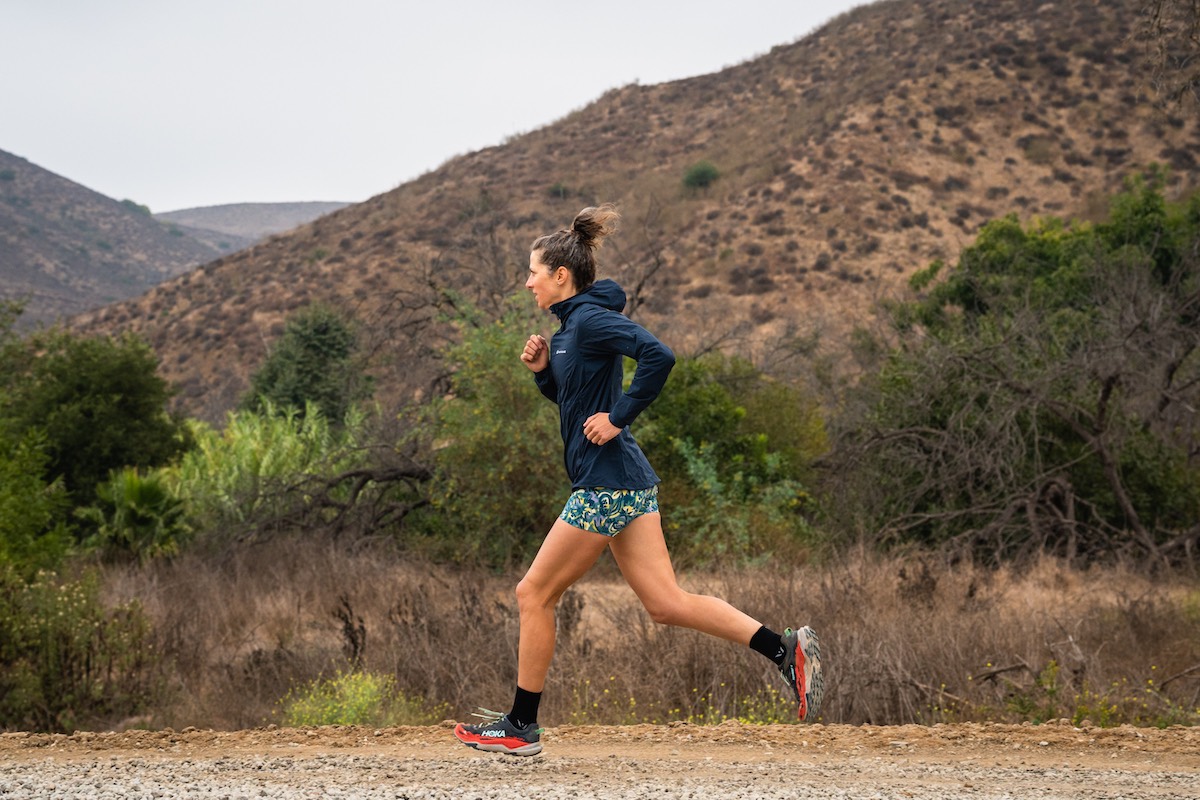
The Hoka Torrent 4 trail running shoes are some of our favorite shoes for the trails. Photo: iRunFar/Eszter Horanyi
Stack Height and Drop
Stack height is measured at the heel and toe as the distance between your foot and the ground, or the amount of material between the bottom of your foot and the ground. The difference between the heel’s stack height and the toe’s stack height is the drop. So if a shoe has a 33-millimeter heel height and a 28-millimeter toe height, the drop is 5 millimeters.
Not surprisingly, Hoka’s shoes generally have higher stack heights, with the heel stack heights on this list ranging between 30 and 36 millimeters, but they generally have mid-range drops, mainly 4 or 5 millimeters. Drops typically range between 0 and 12 millimeters in running shoes. The Hoka Skyward X has the highest stack height in this guide, with a massive 48 millimeters of foam under the heel.
Lugs
Lugs are the protrusions you find on the bottom of your shoes and are often between 3 to 6 millimeters tall on trail shoes. You generally won’t be measuring lugs in millimeters on road shoes. Shoes designed for mud, ice, and slush might have lugs up to 10 millimeters. The Hoka Mafate Speed 4 is the luggiest shoe in this guide, and the lugs on the Hoka Speedgoat 6 and Hoka Torrent 4 provide plenty of grip on most types of terrain as well.
Materials
Running shoes — Hokas included — are generally made of three different materials: rubber outsoles, foam midsoles, and mesh uppers. Different materials work for different types of running. For example, you’ll probably see tougher and stickier rubber used on trail running outsoles than road running outsoles. The foam will often be the same between road and trail shoes, but the uppers of trail shoes might have tougher or thicker mesh to protect from debris compared to road running shoes, which are more minimalistic. The Hoka Mafate Speed 4 uses the same midsole foam as many of the brand’s road shoes but has an outsole and upper fit for trails.
Price and Durability
Running shoes are expensive these days, and Hokas are no exception. The shoes on this list range from $130 for the Hoka Torrent 4 to $250 for the Hoka Rocket X 3, which is standard for any high-quality running shoe. Still, shoes go on sale often, especially when a brand phases out a previous model. If budget is a significant factor, keep your eyes peeled for deals. If you know you really like a specific model and it goes on sale, stock up.
Overall, Hoka shoes are quite durable. Our main tester has no problem reaching up to 500 miles in a pair, which is probably too much for any pair of shoes. One way to increase your shoes’ longevity is to rotate between a few pairs at a time. You can also remove the insole after running and wipe it down with a cloth to remove dirt, grime, and other debris that could increase the rate of wear.
Why You Should Trust Us
The iRunFar team includes road, trail, and ultrarunners with collectively 150-plus years of running experience. We drew upon their expertise and experience with Hoka running shoes to put this buyer’s guide together. Author Nathan Allen is a former collegiate track and cross-country athlete who can’t seem to let the running dream die. He consistently logs miles and has run in different Hoka models for a decade. His current rotation includes the Hoka Clifton 10 and Hoka Rocket X 3 for roads and the Hoka Mafate Speed 4, Hoka Challenger 8, and Hoka Tecton X 3 for trails. He’s put at least 100 miles on each shoe in this guide, and some of them get nearly 500 miles.
Frequently Asked Questions About Hoka Running Shoes
What is the best Hoka for a marathon?
For a road marathon, we highly recommend the Hoka Rocket X 3. They’re the closest thing you’ll find to a super shoe from Hoka, but they are not to the level of the Nike Vaporfly, Asics Metaspeed Sky, or Saucony Endorphin Elite 2. The other option, especially if you value comfort over time, is the Hoka Clifton 10 or Hoka Mach 6. If a trail marathon is in your plans, the Hoka Speedgoat 6 and Hoka Torrent 4 are both excellent choices. The Hoka Tecton X 3 could also work, but that’d be the upper limit of its distance capabilities.
You can check out other options in our Best Marathon Shoes guide.
Why are Hoka shoes so popular?
Hoka shoes have gained popularity for their maximum cushion construction. Aging and some younger runners have gravitated toward the brand for shoes that make the ground a little softer, thanks to all that extra cushion. They’ve gained even more popularity among people who spend a lot of time working on their feet, like nurses and others in the medical field. Many Hokas, including the Hoka Clifton 10, have earned the American Podiatrist Medical Association Seal of Acceptance, which is given to shoes that promote good foot health.
Do I need a Hoka road shoe or a trail shoe?
Unless you run exclusively on roads or trails, having both road- and trail-specific shoes in your rotation is good. If you primarily run on trails, the Hoka Speedgoat 6 and Hoka Torrent 4 are great all-around shoes that will provide plenty of grip on most types of terrain while still cushioning your feet as the miles add up. If you primarily run on roads, the Hoka Clifton 10 provides a great balance between comfort, speed, and cushion. If you run on both roads and trails but only want one shoe, the hybrid Hoka Challenger 8 can handle all types of terrain.
Call for Comments
- What are your favorite Hoka running shoes?
- Do you have a favorite Hoka running shoe you think should be included on this list?
